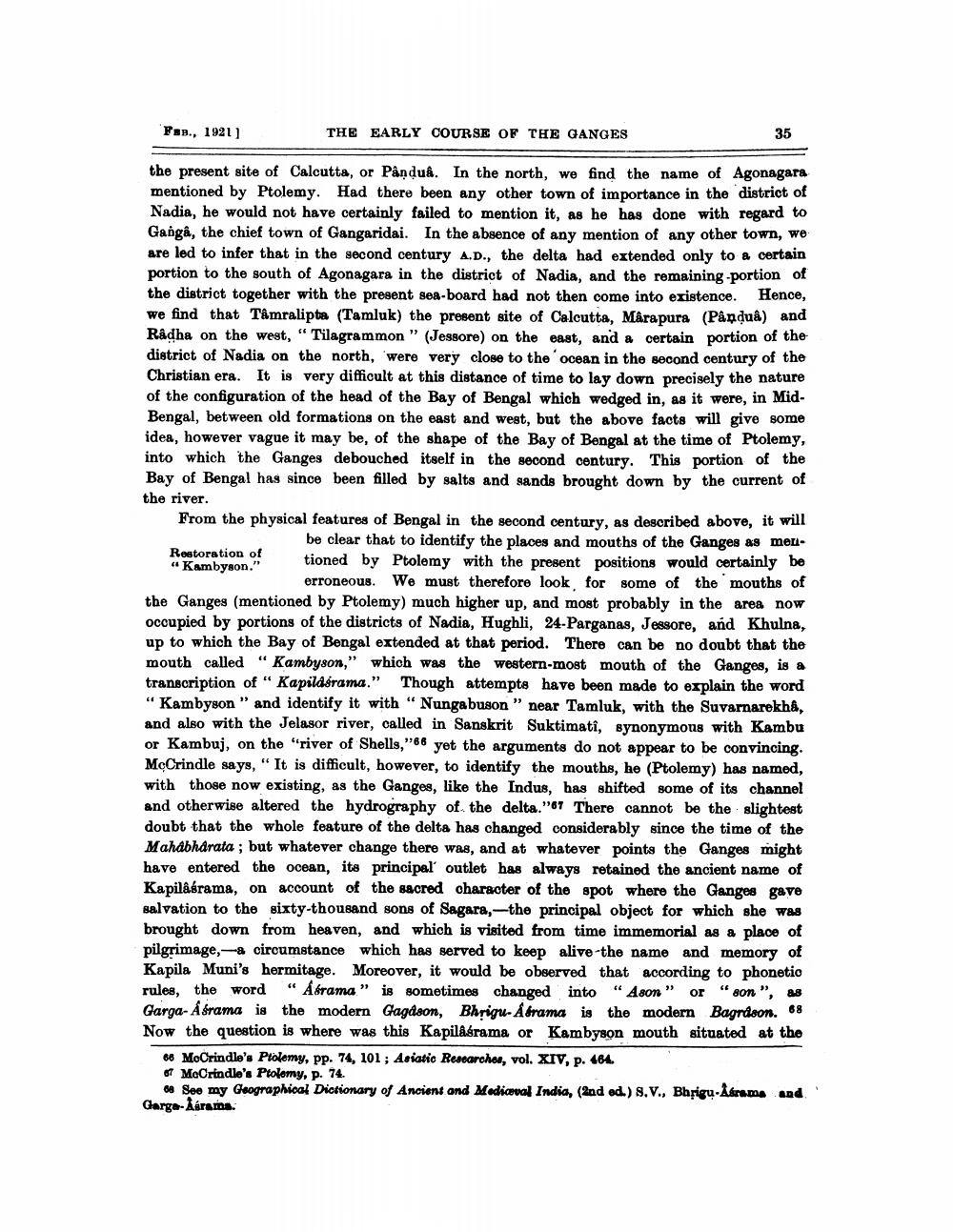________________
Fas., 1921)
THE EARLY COURSE OF THE GANGES
35
the present site of Calcutta, or Pånd. In the north, we find the name of Agonagara mentioned by Ptolemy. Had there been any other town of importance in the district of Nadia, he would not have certainly failed to mention it, as he has done with regard to Ganga, the chief town of Gangaridai. In the absence of any mention of any other town, we are led to infer that in the second century A.D., the delta had extended only to a certain portion to the south of Agonagara in the district of Nadia, and the remaining -portion of the district together with the present sea-board had not then come into existence. Hence, we find that Tamralipta (Tamluk) the present site of Calcutta, Marapura (Pandua) and Radha on the west, "Tilagrammon" (Jessore) on the east, and a certain portion of the district of Nadia on the north, were very close to the ocean in the second century of the Christian era. It is very difficult at this distance of time to lay down precisely the nature of the configuration of the head of the Bay of Bengal which wedged in, as it were, in MidBengal, between old formations on the east and west, but the above facts will give some idea, however vague it may be, of the shape of the Bay of Bengal at the time of Ptolemy, into which the Ganges debouched itself in the second century. This portion of the Bay of Bengal has since been filled by salts and sands brought down by the current of the river. From the physical features of Bengal in the second century, as described above, it will
be clear that to identify the places and mouths of the Ganges as metRestoration of "Kambyson."
tioned by Ptolemy with the present positions would certainly be
erroneous. We must therefore look for some of the mouths of the Ganges (mentioned by Ptolemy) much higher up, and most probably in the area now occupied by portions of the districts of Nadia, Hughli, 24-Parganas, Jessore, and Khulna, up to which the Bay of Bengal extended at that period. There can be no doubt that the mouth called " Kambyson," which was the western-most mouth of the Ganges, is a transcription of " Kapildsrama." Though attempts have been made to explain the word “Kambyson " and identify it with "Nungabuson " near Tamluk, with the Suvarnarekha, and also with the Jelasor river, called in Sanskrit Suktimati, synonymous with Kambu or Kambuj, on the "river of Shells,"66 yet the arguments do not appear to be convincing. McCrindle says, “It is difficult, however, to identify the mouths, he (Ptolemy) has named, with those now existing, as the Ganges, like the Indus, has shifted some of its channel and otherwise altered the hydrography of the delta."67 There cannot be the slightest doubt that the whole feature of the delta has changed considerably since the time of the Mahabharata ; but whatever change there was, and at whatever points the Ganges might have entered the ocean, its principal outlet has always retained the ancient name of Kapilâśrama, on account of the sacred character of the spot where the Ganges gave salvation to the sixty-thousand sons of Sagara,--the principal object for which she was brought down from heaven, and which is visited from time immemorial as a place of pilgrimage, ciroumstance which has served to keep alive the name and memory of Kapila Muni's hermitage. Moreover, it would be observed that according to phonetio rules, the word "Asrama" is sometimes changed into " Ason" or "son", as Garga- A drama is the modern Gagdson, Bhrigri- Áframa is the modern Bagrdson. 68 Now the question is where was this Kapilâśrama or Kambyson mouth situated at the
80 MoOrindle's Ptolemy, pp. 74, 101 ; Asiatic Research, vol. XIV, p. 464. of MoOrindlo's Ptolomy, p. 74
08 See my Geographical Dictionary of Ancient and Medical India, (2nd ed.) 8.V., Bhrigu.Abrams and Garga-Asrarna.




